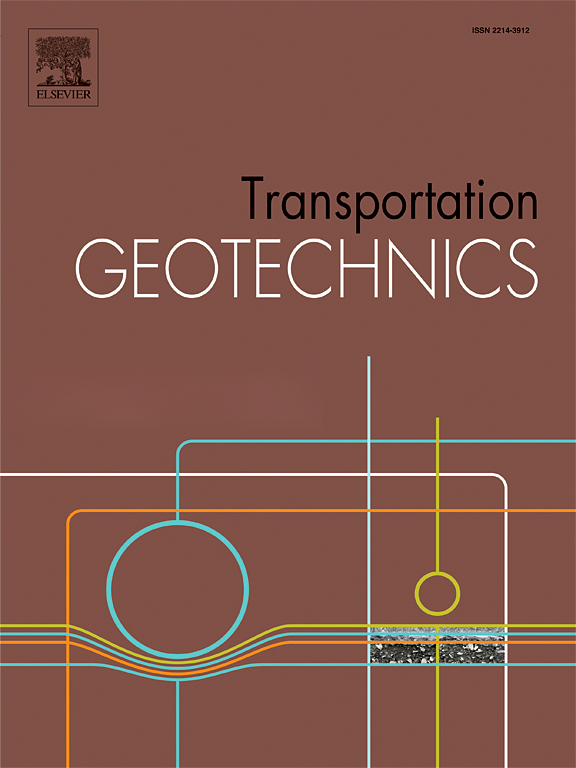Effect of cyclic wetting on lateritic clay subgrade settlement and train-track dynamic response of high-speed railway
IF 4.9
2区 工程技术
Q1 ENGINEERING, CIVIL
引用次数: 0
Abstract
Cyclic wetting of high-speed railway subgrade leads to excessive uneven settlement and intense wheel-rail dynamic response, seriously affecting operation comfort and safety. In this paper, the effect of cyclic wetting on accumulative deformation of lateritic clay was investigated by dynamic triaxial test. Incorporating the cyclic wetting effect, a prediction model of accumulative strain was developed for compacted lateritic clay. By considering dynamic accumulative strain as static creep, a novel method for calculating subgrade long-term settlement was proposed. Moreover, a 3-D train-track-subgrade coupled dynamic model was established accounting for evolving contact stress between track and subgrade, and the effectiveness was verified. The influence of moisture content, cyclic wetting times and dynamic stress on the subgrade settlement evolution was analysed. The vertical carbody acceleration, Sperling index, derailment coefficient and wheel load reduction rate were selected as evaluation indexes to study the influence of cyclic wetting on train operation performance. The results show that the accumulative strain increases nonlinearly with the increase of wetting amplitude, existing a critical moisture content of 1.5% above the optimal moisture content, exceeding which the accumulative plastic strain increases significantly. The accumulative strain increases significantly when the moisture content exceeds the critical value. With the increase of moisture content, cyclic wetting times and dynamic stress, the accumulative deformation of lateritic clay gradually changes from a stable type to an incremental damage type. With the increase of train speed, the growth rate of carbody vertical acceleration and Sperling index accelerate, resulting in greater sensitivity to cyclic wetting. For safe operations of high-speed railway, it is not recommended that the subgrade moisture content exceeds the critical moisture content.
循环润湿对高速铁路红土粘土路基沉降及列车-轨道动力响应的影响
高速铁路路基的循环润湿导致沉降过大,轮轨动力响应强烈,严重影响了运行的舒适性和安全性。采用动态三轴试验方法,研究了循环润湿对红土粘土累积变形的影响。考虑循环润湿效应,建立了压实红土粘土累积应变预测模型。将动态累积应变视为静态蠕变,提出了一种计算路基长期沉降的新方法。建立了考虑轨道与路基接触应力演化的列车-轨道-路基三维耦合动力模型,验证了模型的有效性。分析了含水率、循环润湿次数和动应力对路基沉降演变的影响。以纵向车体加速度、斯珀林指数、脱轨系数和轮载减载率为评价指标,研究循环润湿对列车运行性能的影响。结果表明:累积应变随润湿幅值的增加呈非线性增长,在最佳含水率之上存在1.5%的临界含水率,超过该临界含水率,累积塑性应变显著增加;当含水率超过临界值时,累积应变显著增加。随着含水率、循环润湿次数和动应力的增加,红土粘土的累积变形逐渐由稳定型向增量损伤型转变。随着列车速度的增加,车体垂直加速度和斯珀林指数的增长速度加快,对循环润湿的敏感性增大。为了高速铁路的安全运行,不建议路基含水率超过临界含水率。
本文章由计算机程序翻译,如有差异,请以英文原文为准。
求助全文
约1分钟内获得全文
求助全文
来源期刊

Transportation Geotechnics
Social Sciences-Transportation
CiteScore
8.10
自引率
11.30%
发文量
194
审稿时长
51 days
期刊介绍:
Transportation Geotechnics is a journal dedicated to publishing high-quality, theoretical, and applied papers that cover all facets of geotechnics for transportation infrastructure such as roads, highways, railways, underground railways, airfields, and waterways. The journal places a special emphasis on case studies that present original work relevant to the sustainable construction of transportation infrastructure. The scope of topics it addresses includes the geotechnical properties of geomaterials for sustainable and rational design and construction, the behavior of compacted and stabilized geomaterials, the use of geosynthetics and reinforcement in constructed layers and interlayers, ground improvement and slope stability for transportation infrastructures, compaction technology and management, maintenance technology, the impact of climate, embankments for highways and high-speed trains, transition zones, dredging, underwater geotechnics for infrastructure purposes, and the modeling of multi-layered structures and supporting ground under dynamic and repeated loads.
 求助内容:
求助内容: 应助结果提醒方式:
应助结果提醒方式:


